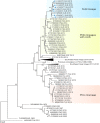Multiple arboviral infections during a DENV-2 outbreak in Solomon Islands
- PMID: 32435149
- PMCID: PMC7225641
- DOI: 10.1186/s41182-020-00217-8
Multiple arboviral infections during a DENV-2 outbreak in Solomon Islands
Erratum in
-
Correction to: Multiple arboviral infections during a DENV-2 outbreak in Solomon Islands.Trop Med Health. 2020 Jun 11;48:45. doi: 10.1186/s41182-020-00227-6. eCollection 2020. Trop Med Health. 2020. PMID: 32536787 Free PMC article.
Abstract
Background: Solomon Islands, a country made up of tropical islands, has suffered cyclic dengue fever (DF) outbreaks in the past three decades. An outbreak of dengue-like illness (DLI) that occurred in April 2016 prompted this study, which aimed to determine the population's immunity status and identify the arboviruses circulating in the country.
Methods: A household survey, involving 188 participants in two urban areas (Honiara and Gizo), and a parallel hospital-based clinical survey were conducted in April 2016. The latter was repeated in December after a surge in DLI cases. Arbovirus IgG ELISA were performed on the household blood samples to determine the prevalence of arboviruses in the community, while qPCR testing of the clinical samples was used to identify the circulating arboviruses. Dengue virus (DENV)-positive samples were further characterized by amplifying and sequencing the envelope gene.
Results: The overall prevalence rates of DENV, Zika virus, and chikungunya virus were 83.4%, 7.6%, and 0.9%, respectively. The qPCR positivity rates of the clinical samples collected in April 2016 were as follows: DENV 39.6%, Zika virus 16.7%, and chikungunya virus 6.3%, which increased to 74%, 48%, and 20% respectively in December 2016. The displacement of the circulating serotype-3, genotype-1, with DENV serotype 2, genotype cosmopolitan was responsible for the outbreak in 2016.
Conclusions: A DENV outbreak in Solomon Islands was caused by the introduction of a single serotype. The high prevalence of DENV provided transient cross-protection, which prevented the introduction of a new serotype from the hyperendemic region for at least 3 years. The severe outcomes seen in the recent outbreak probably resulted from changes in the causative viruses and the effects of population immunity and changes in the outbreak pattern. Solomon Islands needs to step up surveillance to include molecular tools, increase regional communication, and perform timely interventions.
Keywords: Arbovirus; Dengue fever; Immunity; Molecular; Seroprevalence.
© The Author(s) 2020.
Conflict of interest statement
Competing interestsThe authors confirm that there are no known conflicts of interest associated with this publication and there has been no significant financial support for this work that could have influenced its outcomes.
Figures





References
-
- WHO. Global strategy for dengue prevention and control, 2012–2020. Diseases DoCoNT, editorAugust 2012.
LinkOut - more resources
Full Text Sources
Miscellaneous
